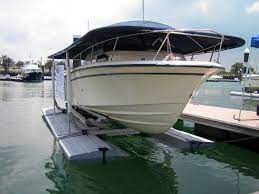
If your boat is being lifted for anything more than an hour or so, often called a “short haul,” it is likely that it will be placed on blocks in the yard and supported with jack stands. If this is the case, tell the yard about any relevant structural features of your boat. Some down east powerboats, for example, have hollow keels aft, which could potentially suffer damage if the boat is improperly blocked and supported. In cases like this, blocks should probably run lengthwise rather than athwart ships to provide adequate support.
General Rule
As a general rule, when in a short haul situation, the workers in the yard have much experience moving and blocking boats, so it’s best to leave it up to them as to how they do it. By all means watch, but don’t interfere unless you see something that is wrong or unsafe; if you see a problem, bring it up with the yard manager.
Once the boat is settled into her spot, inspect the jack stands. Ensure they have chains between them to prevent them from spreading, which could cause the boat to fall over. Be sure that the attachment points of the chain to the jack stands are secure. Sometimes the slits in the metal of the frame into which the chain links sit are torn or bent from use, which could result in slipping or failure. If a stand is severely rusted, ask to have it replaced.
Check the Ground
Also check the ground beneath the jack stands. If the stands are resting on, for example, sandy or loose soil, and especially if there’s a slope, this may present a problem in heavy rains. The majority of jack stands will have three or four legs and unless they are on a solid surface, they should have sturdy plywood pads or other good support placed underneath to distribute the weight over a larger surface area, preventing them from sinking into the ground. If you see any problems, discuss them with management as soon as possible.